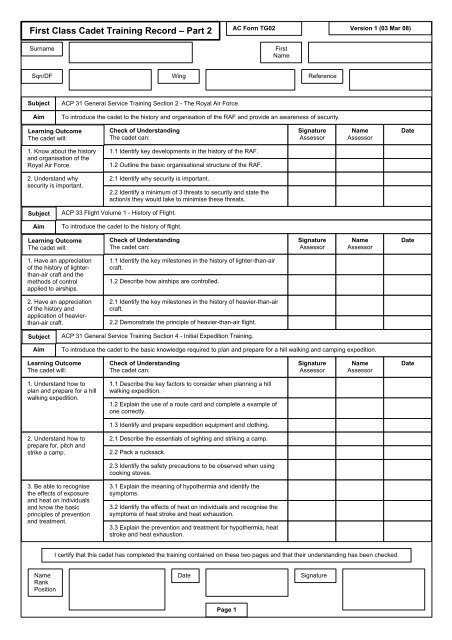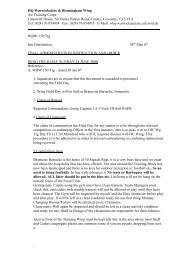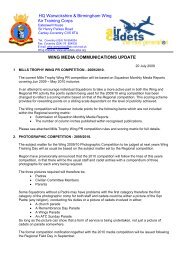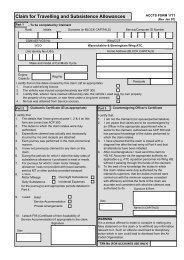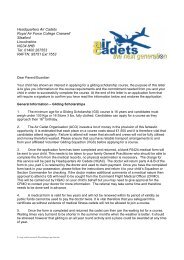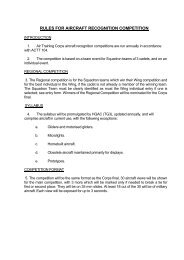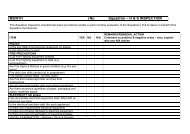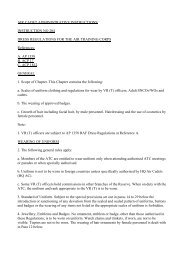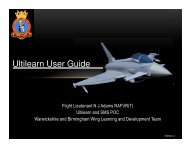ACF TG02 First Class Cadet Training Record Part 2
ACF TG02 First Class Cadet Training Record Part 2
ACF TG02 First Class Cadet Training Record Part 2
- No tags were found...
You also want an ePaper? Increase the reach of your titles
YUMPU automatically turns print PDFs into web optimized ePapers that Google loves.
<strong>First</strong> <strong>Class</strong> <strong>Cadet</strong> <strong>Training</strong> <strong>Record</strong> – <strong>Part</strong> 2AC Form <strong>TG02</strong> Version 1 (03 Mar 08)Surname<strong>First</strong>NameSqn/DF Wing ReferenceSubjectAimACP 31 General Service <strong>Training</strong> Section 2 - The Royal Air Force.To introduce the cadet to the history and organisation of the RAF and provide an awareness of security.Learning OutcomeThe cadet will:Check of UnderstandingThe cadet can:SignatureAssessorNameAssessorDate1. Know about the historyand organisation of theRoyal Air Force.1.1 Identify key developments in the history of the RAF.1.2 Outline the basic organisational structure of the RAF.2. Understand whysecurity is important.2.1 Identify why security is important.2.2 Identify a minimum of 3 threats to security and state theaction/s they would take to minimise these threats.SubjectAimACP 33 Flight Volume 1 - History of Flight.To introduce the cadet to the history of flight.Learning OutcomeThe cadet will:Check of UnderstandingThe cadet can:SignatureAssessorNameAssessorDate1. Have an appreciationof the history of lighterthan-aircraft and themethods of controlapplied to airships.1.1 Identify the key milestones in the history of lighter-than-aircraft.1.2 Describe how airships are controlled.2. Have an appreciationof the history andapplication of heavierthan-aircraft.2.1 Identify the key milestones in the history of heavier-than-aircraft.2.2 Demonstrate the principle of heavier-than-air flight.SubjectAimACP 31 General Service <strong>Training</strong> Section 4 - Initial Expedition <strong>Training</strong>.To introduce the cadet to the basic knowledge required to plan and prepare for a hill walking and camping expedition.Learning OutcomeThe cadet will:Check of UnderstandingThe cadet can:SignatureAssessorNameAssessorDate1. Understand how toplan and prepare for a hillwalking expedition.1.1 Describe the key factors to consider when planning a hillwalking expedition.1.2 Explain the use of a route card and complete a example ofone correctly.1.3 Identify and prepare expedition equipment and clothing.2. Understand how toprepare for, pitch andstrike a camp.2.1 Describe the essentials of sighting and striking a camp.2.2 Pack a rucksack.2.3 Identify the safety precautions to be observed when usingcooking stoves.3. Be able to recognisethe effects of exposureand heat on individualsand know the basicprinciples of preventionand treatment.3.1 Explain the meaning of hypothermia and identify thesymptoms.3.2 Identify the effects of heat on individuals and recognise thesymptoms of heat stroke and heat exhaustion.3.3 Explain the prevention and treatment for hypothermia, heatstroke and heat exhaustion.I certify that this cadet has completed the training contained on these two pages and that their understanding has been checked.NameRankPositionDateSignaturePage 1
SubjectAimACP 31 General Service <strong>Training</strong> Section 6 - Basic Radio Communications.To introduce the cadet to a radio network, operating procedures and the safe use of radio equipment.Learning OutcomeThe cadet will:Check of UnderstandingThe cadet can:SignatureAssessorNameAssessorDate1. Understand how tosend a message on anAir <strong>Cadet</strong> radio network.1.1 Describe the basic features of an Air <strong>Cadet</strong> radio network.1.2 Use the phonetic alphabet for the spelling of words and theconveyance of figures in a radio message.1.3 Use radio procedures to convey a clear and brief message.2. Understand the typesand effectiveness of radioequipment used withinthe Air <strong>Cadet</strong>Organisation.2.1 Describe the function and characteristics of various types ofradio equipment used within Air <strong>Cadet</strong> networks.2.2 Explain how the frequency of operation of radio equipmentcan limit its use.2.3 Explain how an aerial can affect the range of radiotransmissions.3. Understand theprocedures needed forthe safe use of radioswithin the Air <strong>Cadet</strong>Organisation.3.1 Explain the safe care and handling of radio batteries.3.2 Identify safety procedures used when using portable radioequipment.3.3 Identify and describe the basic health and safety issuesassociated with radio operations.SubjectAimACP 32 Navigation Volume 1 - Map ReadingTo introduce the cadet to the basics of map reading using Ordinance Survey maps and applying these concepts to practical situations.Learning OutcomeThe cadet will:Check of UnderstandingThe cadet can:SignatureAssessorNameAssessor1. Understand the scalesand features of OrdinanceSurvey (OS) maps.1.1 Explain the use of scales on an OS map.1.2 Identify the main symbols on an OS map.1.3 Explain the use of contour lines on an OS map.2. Be able to use the gridreferencing system ofOrdinance Survey (OS)maps to find a location.2.1 Explain the grid referencing system used on OS maps.2.2 Use grid referencing to locate a point on an OS map.2.3 Demonstrate how to calculate distance using an OS map.3. Understand how toplan routes usingOrdinance Survey (OS)map features and contourlines.3.1 Describe the lie of the land from contour lines on a map.3.2 Calculate the gradient of a slop from map information.3.3 Draw a land profile by projection from map contour lines.3.4 Explain why line of sight may not always be reliable.SubjectAimACP 34 Aircraft Operations Volume 1 - Airmanship 1To introduce the cadet to general features of an airfield, identify key features on selected aircraft and be aware of pre-flight briefings.Learning OutcomeThe cadet will:Check of UnderstandingThe cadet can:SignatureAssessorNameAssessor1. Know the importantfeatures of an airfield.1.1 Use correct terminology to describe the layout of an airfield.1.2 Identify runway marking and numbering.1.3 Indentify the types and locations airfield lighting.2. Know the features of apassenger pre-flightbriefing for an airexperience flight.2.1 Describe the content of a passenger pre-flight briefing.2.2 Identify the safety equipment worn and its uses.2.3 Describe the actions to be taken in an emergency in the air.3. Know the types andfeatures of aircraft usedfor air experience flyingand gliding.3.1 Describe key features of either a Tutor, Vigilant or Viking.3.2 Identify the flight instruments and controls of either a Tutor,Vigilant or Viking.3.3 Identify the differences in operation of winch-launched andself-launched gliders.Page 2


